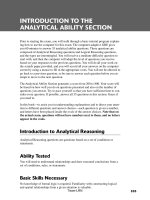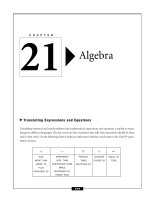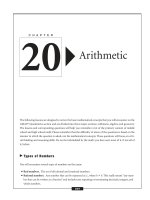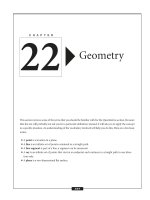The GMAT Quantitative Section - Geometry
Bạn đang xem bản rút gọn của tài liệu. Xem và tải ngay bản đầy đủ của tài liệu tại đây (135.62 KB, 12 trang )
This section reviews some of the terms that you should be familiar with for the Quantitative section. Be aware
that the test will probably not ask you for a particular definition; instead, it will ask you to apply the concept
to a specific situation. An understanding of the vocabulary involved will help you do this. Here are a few basic
terms:
■
A point is a location in a plane.
■
A line is an infinite set of points contained in a straight path.
■
A line segment is part of a line; a segment can be measured.
■
A ray is an infinite set of points that start at an endpoint and continue in a straight path in one direc-
tion only.
■
A plane is a two-dimensional flat surface.
CHAPTER
Geometry
22
357
Angles
Two rays with a common endpoint, called a vertex, form an angle. The following figures show the different
types of angles:
Acute Right
The measure is between 0 and 90 degrees. The measure is equal to 90 degrees.
Obtuse Straight
The measure is between 90 and 180 degrees. The measure is equal to 180 degrees.
Here are a few tips to use when determining the measure of the angles.
■
A pair of angles is complementary if the sum of the measures of the angles is 90 degrees.
■
A pair of angles is supplementary if the sum of the measures of the angles is 180 degrees.
■
If two angles have the same measure, then they are congruent.
■
If an angle is bisected, it is divided into two congruent angles.
Lines and Angles
When two lines intersect, four angles are formed.
1
2
3
4
vertex
–
GEOMETRY
–
358
Vertical angles are the nonadjacent angles formed, or the opposite angles. These angles have the same
measure. For example, m ∠ 1 = m ∠ 3 and m ∠ 2 = m ∠ 4.
The sum of any two adjacent angles is 180 degrees. For example, m ∠ 1 ϩ m ∠ 2 = 180. The sum of all
four of the angles formed is 360 degrees.
If the two lines intersect and form four right angles, then the lines are perpendicular. If line m is per-
pendicular to line n, it is written m Ќ n. If the two lines are in the same plane and will never intersect, then
the lines are parallel. If line l is parallel to line p, it is written l || p.
Parallel Lines and Angles
Some special angle patterns appear when two parallel lines are cut by another nonparallel line, or a transversal.
When this happens, two different-sized angles are created: four angles of one size, and four of another size.
■
Corresponding angles. These are angle pairs 1 and 5, 2 and 6, 3 and 7, and 4 and 8. Within each pair,
the angles are congruent to each other.
■
Alternate interior angles. These are angle pairs 3 and 6, and 4 and 5. Within the pair, the angles are
congruent to each other.
■
Alternate exterior angles. These are angle pairs 1 and 8, and 2 and 7. Within the pair, the angles are
congruent to each other.
■
As in the case of two intersecting lines, the adjacent angles are supplementary and the vertical angles
have the same measure.
Polygons
A polygon is a simple closed figure whose sides are line segments. The places where the sides meet are called
the vertices of the polygon. Polygons are named, or classified, according to the number of sides in the figure.
The number of sides also determines the sum of the number of degrees in the interior angles.
12
3
4
5
6
7
8
t
l
m
l ԽԽ m
t
is the transversal
–
GEOMETRY
–
359
The total number of degrees in the interior angles of a polygon can be determined by drawing the non-
intersecting diagonals in the polygon (the dashed lines in the previous figure). Each region formed is a tri-
angle; there are always two fewer triangles than the number of sides. Multiply 180 by the number of triangles
to find the total degrees in the interior vertex angles. For example, in the pentagon, three triangles are formed.
Three times 180 equals 540; therefore, the interior vertex angles of a pentagon is made up of 540 degrees. The
formula for this procedure is 180 (n – 2), where n is the number of sides in the polygon.
The sum of the measures of the exterior angles of any polygon is 360 degrees.
A regular polygon is a polygon with equal sides and equal angle measure.
Two polygons are congruent if their corresponding sides and angles are equal (same shape and same
size).
Two polygons are similar if their corresponding angles are equal and their corresponding sides are in
proportion (same shape, but different size).
Triangles
Triangles can be classified according to their sides and the measure of their angles.
Equilateral Isosceles Scalene
All sides are congruent. Two sides are congruent. All sides have a different measure.
All angles are congruent. Base angles are congruent. All angles have a different measure.
This is a regular polygon.
60°
60° 60°
180°
360° 540° 720°
3-SIDED
TRIANGLE
4-SIDED
QUADRILATERAL
5-SIDED
PENTAGON
6-SIDED
HEXAGON
–
GEOMETRY
–
360
Acute Right Obtuse
The measure of each It contains one It contains one angle that is greater than 90
angle is less than 90 90-degree angle. degrees.
degrees.
Triangle Inequality
The sum of the two smaller sides of any triangle must be larger than the third side. For example, if the meas-
ures 3, 4, and 7 were given, those lengths would not form a triangle because 3 + 4 = 7, and the sum must be
greater than the third side. If you know two sides of a triangle and want to find a third, an easy way to han-
dle this is to find the sum and difference of the two known sides. So, if the two sides were 3 and 7, the meas-
ure of the third side would be between 7 – 3 and 7 + 3. In other words, if x was the third side, x would have
to be between 4 and 10, but not including 4 or 10.
Right Triangles
In a right triangle, the two sides that form the right angle are called the legs of the triangle. The side oppo-
site the right angle is called the hypotenuse and is always the longest side of the triangle.
Pythagorean Theorem
To find the length of a side of a right triangle, the Pythagorean theorem can be used. This theorem states that
the sum of the squares of the legs of the right triangle equal the square of the hypotenuse. It can be expressed
as the equation a
2
+ b
2
= c
2
,where a and b are the legs and c is the hypotenuse. This relationship is shown
geometrically in the following diagram.
b
2
2
c
2
a
b
c
a
angle
greater
than 90°
60°
50°
70°
–
GEOMETRY
–
361









